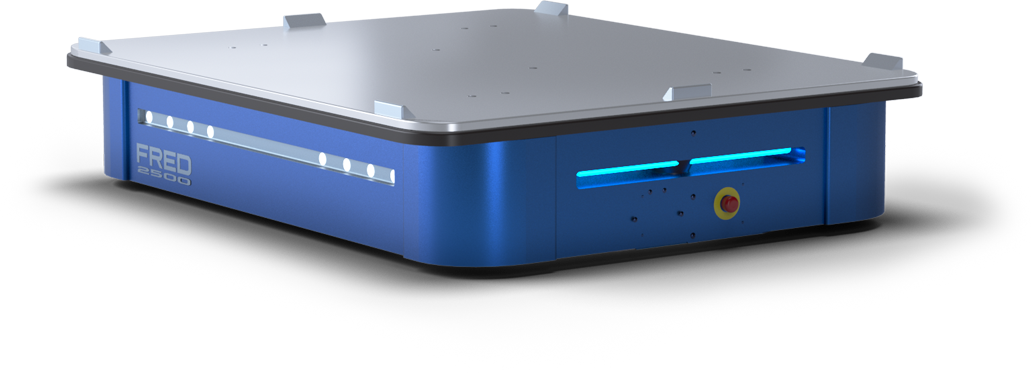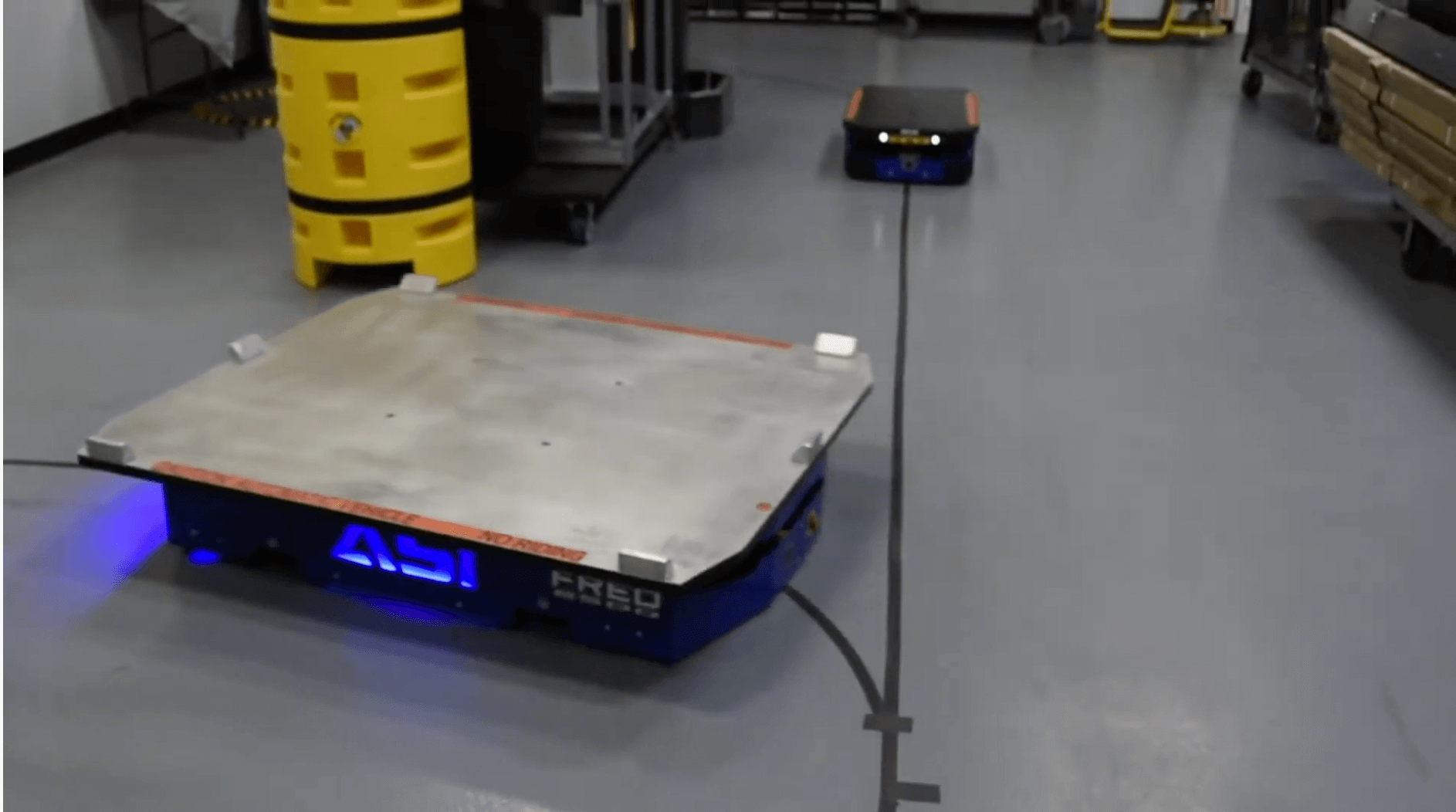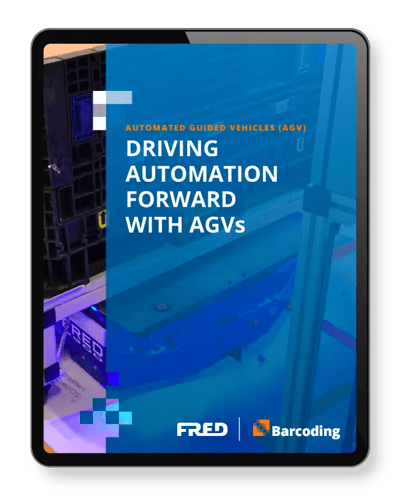We’ve written many articles on how productive an AGV can be for your facility. From their ability to work long hours to their propensity for keeping humans safe and distanced, there are many reasons why an AGV is an investment worth making. But what if you need more help than one AGV can offer? The answer is pretty simple, actually: multiple AGVs.
Whatever one AGV can do, multiple AGVs can do even better. It sounds like a pretty obvious solution, but we understand that even one AGV can be a high investment—meaning that investing in an entire fleet might seem like an overwhelming financial undertaking. This financial roadblock was one of the main reasons we created FRED/FREDDiE. For the cost of the average AGV you can employ a whole fleet of FREDs and FREDDiEs, putting together the kind of system that keeps your space productive and efficient.
AGV systems are multiple AGVs that navigate along paths, either on magnetic strips or otherwise pre-defined routes. For instance, FRED/FREDDiE runs along easy-to-install magnetic strips that you can position and/or move around in about two hours, depending on the size of your space. This makes it easy to change routes and add to the system in response to changes within the workplace, or if you need to add more AGVs.
What would multiple FRED/FREDDiEs look like inside your facility? Let’s look at an example involving palletizers, conveyors and wrappers. Palletizers are one of the most ubiquitous forms of warehouse and factory automation in use today, creating neat, tidy pallets that—once created—need to be moved. A human could move the pallet, but that’s not efficient. A heavy-duty conveyor could move the pallet, but those tend to be huge and expensive. Imagine if, instead of tapping into your valuable workforce or dealing with the challenges of a heavy-duty conveyor, your AGV could collaborate with your robotic palletizer. It would mean less work space traffic, less error and more profit.
You’re probably going to need some kind of conveyor in your facility, especially if you need a pallet feeder. Did you know that an AGV can act as a small conveyor at a fraction of the cost of installing a larger one? FRED for instance, can be configured with a small, powered conveyor mounted on its top surface. In this scenario, once loaded, the AGV will drive from production to the weigh station. There, it can transfer any product to an automatic checkweigher. The checkweigher verifies the product and transfers it back to the AGV, which can then drive to warehousing, logistics or wherever its next stop may be.
That tidy pallet won’t stay that way without unitizing. A properly configured AGV will effectively convert any semi-automatic wrapper into an automatic wrapper. FRED is an example designed expressly to serve this purpose (among many others). Carrying a loaded pallet, FRED drives onto the rotary platform of a turntable wrapper. The platform spins, unitizing the pallet load. FRED then drives off the platform and to, let’s say, your facility’s loading dock. It can be fed from any part of your facility on which you’ve laid a path for FRED. And it can continue on to any other part of your facility.
Now that we’ve looked at how FRED/FREDDiE works for palletizers, conveyors and wrappers individually, let’s see what happens when multiple ones work together. Keep in mind that you can use a fleet of FREDs or FREDDiEs, or you can mix it up and use both. It just depends on what’s right for your facility:
Step 1
FRED (or FREDDiE, depending on the size of the pallets), after being loaded with finished product, drives to an automatic checkweigher.
Step 2
FRED/FREDDiE’s powered-conveyor deposits product onto the checkweigher for verification.
Step 3
The scale verifies the product count before depositing the package back onto FRED/FREDDiE.
Step 4
FRED/FREDDiE drives to its next stop, a mini conveyor that will feed a robotic palletizer.
Step 5
Meanwhile, a second FRED/FREDDiE drives to a pallet feeder.
Step 6
The pallet feeder distributes an empty pallet onto that FRED/FREDDiE.
Step 7
FRED/FREDDiE leaves the pallet feeder, stopping next at the robotic palletizer.
Step 8
The robotic palletizer loads FRED/FREDDiE’s empty pallet.
Step 9
FRED/FREDDiE leaves the robotic palletizer, stopping next at a semi-automatic stretch wrapper.
Step 10
The semi-automatic stretch wrapper securely unitizes FRED/FREDDiE’s pallet load.
Step 11
FRED/FREDDiE leaves the semi-automatic stretch wrapper, stopping next at a loading dock.
Step 12
The workflow starts again.
It’s unlikely any facility will require every automated step in the above workflow. But it demonstrates the exceptional efficiencies brought forth by multiple AGVs. Whatever your challenges, there’s a good chance solutions can be found in AGVs, and FRED/FREDDiE have among the lowest barriers to entry—so you can experience one of the quickest ROI of any AGV on the market.
Automation Questions?
Businesses across many industries are now turning to automation technologies as powerful solutions to once unforeseeable material-movement challenges. We’re here to help you navigate the automation landscape, and drive your business forward. To learn more about how FRED and FREDDiE provide easy-to-implement solutions to complex challenges, contact an ASI Automation specialist today at info@fredagv.com.


